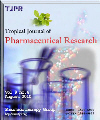
|
Tropical Journal of Pharmaceutical Research
Pharmacotherapy Group, Faculty of Pharmacy, University of Benin, Benin City, Nigeria
ISSN: 1596-5996
EISSN: 1596-5996
Vol. 12, No. 5, 2013, pp. 671-677
|
 Bioline Code: pr13081
Bioline Code: pr13081
Full paper language: English
Document type: Research Article
Document available free of charge
|
|
|
Tropical Journal of Pharmaceutical Research, Vol. 12, No. 5, 2013, pp. 671-677
| en |
Effect of the Various Solvents on the In Vitro Permeability of Vitamin B12 through Excised Rat Skin
Moghimipour, Eskandar; Salimi, Anayatollah & Zadeh, Behzad Sharif Makhmal
Abstract
Purpose: To investigate the effect of different solvents on the In Vitro skin permeability of vitamin B12.
Method: Vitamin B12 (B12) permeability experiments through rat skin pretreated with various solvents namely, propylene glycol, oleoyl macrogol-6-glycerides, propylene glycol monocaprylate and oleic acid, were performed in Franz diffusion cells and compared with hydrated rat skin as control. The permeability parameters evaluated include steady-state flux (Jss), lag time (Tlag), permeability coefficient (Kp) and diffusion coefficient (D). The solvents’ permeability enhancement mechanisms were investigated by comparing of changes in peak position and their intensities of assymmetric (Asy) and symmetric (Sym) C-H stretching, and C=O stretching absorbance using Fourier transform infrared spectroscopy (FTIR), as well as by comparing mean transition temperature (Tm) and their enthalpies (∆H) using differential scanning calorimetery (DSC).
Results: All the solvents significantly decreased diffusion coefficient (p < 0.05), with capryol showing the greatest enhancement ratio (ERD) based on diffusion coefficient followed by labrafil, oleic acid and propylene glycol. Flux enhancement ratio (ERflux) for all the solvents was < ERD. The solubility of B12 in stratum corneum was the rate-limiting step in partitioning. All solvents with different lipophilic properties decreased drug solubility in the stratum corneum and hence lowered partitioning and flux. FTIR and DSC results showed lipid fluidization and extraction by labrafil and capryol, disruption of lipid structure and fluidization by oleic acid, and interaction with stratum corneum keratin by propylene glycol.
Conclusion: Water is a suitable topical vehicle for B12 as it can increase partitioning and diffusion through rat skin
Keywords
Percutaneous absorption; Enhancer; Vitamin B12; Skin permeation; Diffusion coefficient; Flux; Enthalpy
|
| |
© Copyright 2013 - Tropical Journal of Pharmaceutical Research
Alternative site location: http://www.tjpr.org
|
|
